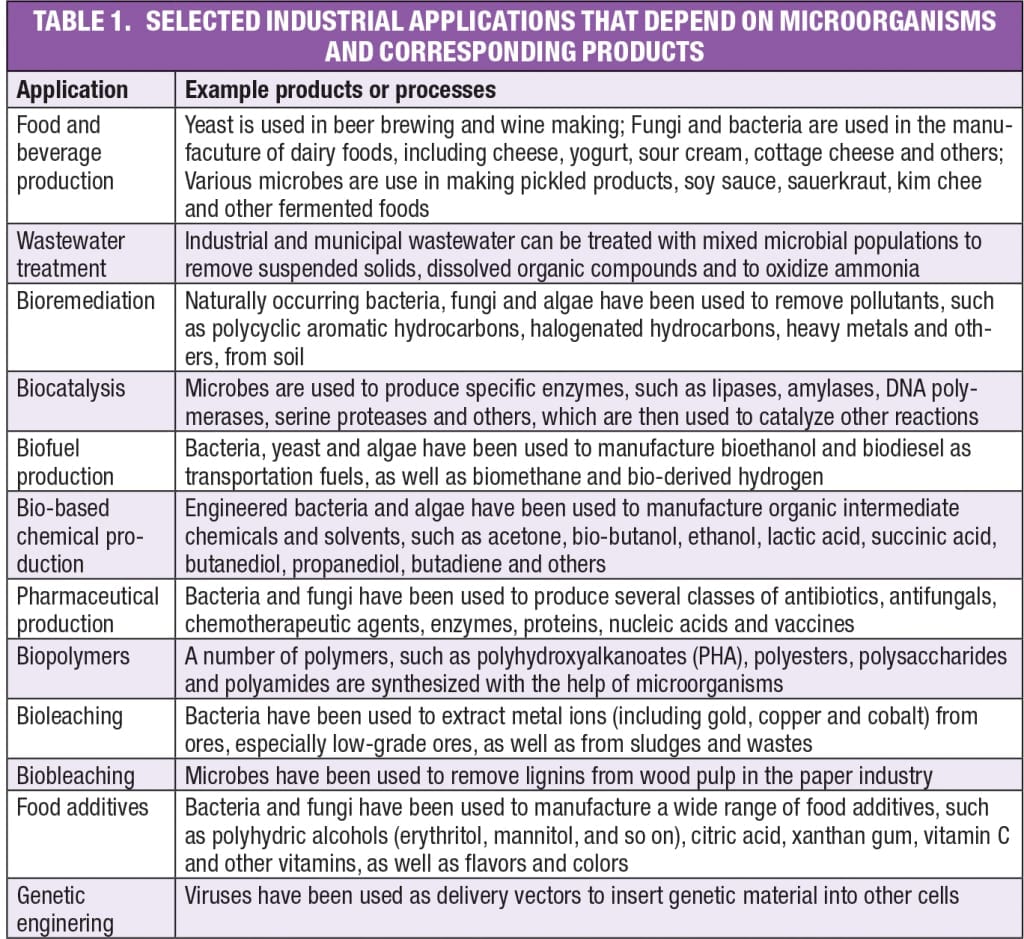Evidence for human use of microorganisms in the production of valuable goods extends back thousands of years. Over the ensuing centuries, the use of microbes in industrial processes has grown steadily, and continues today. This one-page reference provides information on the diversity of industrial processes that utilize microbes, including examples of microbe-dependent products.
Metabolic products
Traditionally, microbes used in fermentation processes have been naturally occurring strains of bacteria and molds that carry out a specific metabolic reaction on a substrate. In the last 25 years, industrial microbes have increasingly been mutant strains engineered to selectively synthesize maximized amounts of various metabolic intermediates. The products of an industrial microbial process can be divided into two broad classes: primary metabolites (produced within the microbes’ major metabolic pathways and essential for microbes’ function), and secondary metabolites (byproducts of metabolism that may not be critical to the microbes’ function). 
Desirable properties
Desirable qualities for effective microorganisms in industrial use include the following:
- Desirable qualities for effective microorganisms in industrial use include the following:
- Ability to grow in culture
- Genetic stability
- Ability to efficiently produce a target product in a short time period
- Limited need for additional growth factors
- Utilization of a wide range of low-cost and readily available carbon sources
- Amenability to genetic engineering
- Non-pathogenicity
- Readily harvested from the fermentation process
- Limited production of byproducts to simplify purification
- Production of spores or other reproductive cells (to allow inoculation into large fermenters)
- Ability to protect itself from contamination by other microbes
- Relatively large cell size, to allow faster settling or simpler filtering
Microbe types
Industrial microorganisms generally fall into one of the following categories: yeasts, fungi (other than yeast), algae, bacteria, archaea and viruses. Algae. The term algae refers to an extremely diverse group of eukaryotes (organisms with defined cellular nuclei), strains of which are used industrially in the production of biofuels, such as biodiesel, and in wastewater treatment, among other uses. Bacteria. Among the earliest life forms, bacteria are prokaryotes (lacking defined nuclei) with staggering metabolic diversity. Industrially, many different bacterial species are used in a wide range of processes from biofuels to pharmaceuticals. Archaea. Similar in many ways to bacteria, archaea constitute a separate class of organisms with distinct metabolic pathways and unique biochemistry. Archaea find limited industrial use, but are used in biogas production, sewage treatment and as a source of heat-tolerant enzymes. Fungi. A family of eukaryotes that includes yeasts, molds and mushrooms, fungi have long been used to produce antibiotics in industry. Yeast. Likely the oldest domesticated microorganism, yeast is a single-celled eukaryote best known industrially for producing ethanol from sugars by fermentation. Viruses. Viruses can be used as delivery vectors for introducing genetic material into other cells.
Key industrial microbe species
- Saccharomyces cerevisiae (yeast for brewing and bread-making)
- Escherichia coli (bacteria for recombinant proteins and others)
- Aspergillus niger (fungus for manufacturing citric acid and enzymes)
- Clostridium butyclicum (bacteria used in soured milk and cheeses)
- Xanthomonas campestri (bacteria that produces xanthan gum)
- Deinococcus radiorans (bacteria for soil and water remediation)
References
1. Garrity, G., Industrial Microbes and Products, Presentation from September 28, 2006, Accessed from Michigan State University, www.msu.edu, February 2015.
2. Waites, M.J., et al., “Industrial Microbiology: an Introduction,” Blackwell Science Ltd., London, 2001.
3. Industrial Microbiology, Nov. 2010, accessed from www.microbialuniverse.com, February 2015.
4. El Ali, B., Industrial Fermentation, Presentation, King Fahd University of Petroleum and Minerals, accessed from www.kfupm.edu.sa, February 2015.
5. Microbes.org